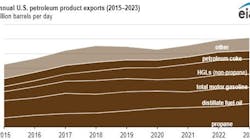By OGJ editors
HOUSTON, Sept. 15 -- Keynote speakers at the World Energy Congress in Montreal this week predicted rising demand for hydrocarbon fuels, especially natural gas, despite growth in the use of alternatives.
Both speakers, Saudi Aramco Pres. and Chief Executive Officer Khalid A. Al-Falih and Royal Dutch Shell PLC Chief Executive Officer Peter Voser, tied their projections to population growth and improving conditions of the world’s poor.
“Some 2 billion people have no access to modern forms of energy, while another 2 billion only enjoy limited access,” said Al-Falih. Population growth of a further 2 billion by the middle of this century and poverty relief ensure structural growth in energy demand.
Coal, oil, and natural gas will “account for four out of every five units of energy that mankind will consume in the foreseeable future,” he said. While their combined share of energy use will give way to growth from alternative sources, total demand for hydrocarbon fuels will grow because of market expansion.
Al-Fathi noted that global coal consumption has grown at an average 4.5%/year this decade after changing little in the 1990s, while oil consumption over the period has grown at about 1.5%/year.
“What is most striking to me is that this acceleration in coal demand came even as attention to climate change was also on the increase and at a time when global warming was becoming a fixture on the global agenda,” he said.
Gas ‘revolution’
Voser said environmental concerns and growing energy needs combine with a supply “revolution” to make the future bright for natural gas.
The revolution has increased energy security for North America and has the potential to perform similarly worldwide, he said. Fulfillment of that potential depends not only on availability of supply but also “on the market forces and government policies that will shape the demand for natural gas.”
The supply revolution, Voser said, results from technical improvements now unlocking production from shales and tight formations and from diversification of gas markets through LNG and, to a lesser extent, gas-to-liquids technology.
“The growth of LNG and the shale and tight gas boom are two mutually reinforcing developments,” Voser said. “They both enhance long-term gas supply security.”
A crucial question is “whether the world’s appetite for natural gas will keep pace with supplies.”
Shell believes global gas demand might rise by one-quarter by 2020 and by almost 50% by 2020 from 110 tcf/year at present.
“The supply will be there, provided there’s a market,” Voser said.
An overall utilization rate of about 40% for existing gas-powered electrical plants on both sides of the Atlantic “means that we can push more gas into the power system and reduce emissions essentially by making better use of what we already have,” he said.
Voser called on governments to forge “a clean electricity coalition between natural gas, renewable, nuclear, and carbon capture and storage technology.”
He said an important move would be to develop carbon markets that deliver robust carbon prices to stimulate investment in low-carbon technologies.
As an alternative, governments can introduce emission-performance standards for power stations.

